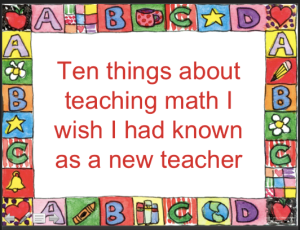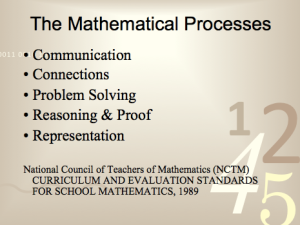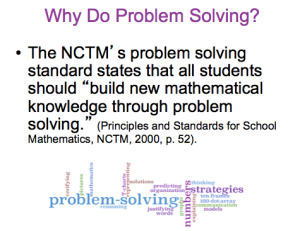 One of the best ways to begin improving problem solving in your math class is simply this: Just do it! Of course. you can learn some techniques for making that problem solving time more of a success than it would otherwise be. You can teach students some strategies for thinking, and help them to use mathematical tools (which I think of as anything concrete or pictorial that helps students build conceptual understanding), but ultimately problem solving is a skill that students master by engaging in it regularly.
One of the best ways to begin improving problem solving in your math class is simply this: Just do it! Of course. you can learn some techniques for making that problem solving time more of a success than it would otherwise be. You can teach students some strategies for thinking, and help them to use mathematical tools (which I think of as anything concrete or pictorial that helps students build conceptual understanding), but ultimately problem solving is a skill that students master by engaging in it regularly.
Linda Gojak, past president of the NCTM, talks about using “rich tasks” in math lessons, and she defines a rich task in this way:
— A situation in which an appropriate path to a solution is not readily apparent
— Can be adapted to maintain high cognitive demand while meeting individual needs
— Requires students to do more than remember a fact or reproduce a skill
— Encourages investigations and deep thinking
— Has multiple entry points, solution paths and at times multiple solutions
I encourage you to look at the tasks you are asking students to do in your lessons and see how they stack up against such a criteria list.
For those attending the session tomorrow, I am not able right now to create a link for downloading the handout, but if you email me (carolleenorris@gmail.com) in the next 10 days I will see that you get a copy of it.
Mathematically yours,
Carollee
 I am delighted to be here in Richmond, BC, today presenting at the BCTF’s New Teachers’ Conference. I am doing a similar workshop to what I did at the Calgary City Teachers’ Convention two weeks ago, but it is well worth the repeat in this city!
I am delighted to be here in Richmond, BC, today presenting at the BCTF’s New Teachers’ Conference. I am doing a similar workshop to what I did at the Calgary City Teachers’ Convention two weeks ago, but it is well worth the repeat in this city! The 100 Dot Array remains one of my favourite tools for helping students visualize numbers. This session at the CCTC focuses mainly on its use with students in grades 2 and 3, although it can be used at many other grade levels. We will be talking about the best way to introduce the tool to students, showing an early activity to help with general number sense, and using the number in problem solving situations. A variety of problem are included to show its diverse use.
The 100 Dot Array remains one of my favourite tools for helping students visualize numbers. This session at the CCTC focuses mainly on its use with students in grades 2 and 3, although it can be used at many other grade levels. We will be talking about the best way to introduce the tool to students, showing an early activity to help with general number sense, and using the number in problem solving situations. A variety of problem are included to show its diverse use.




